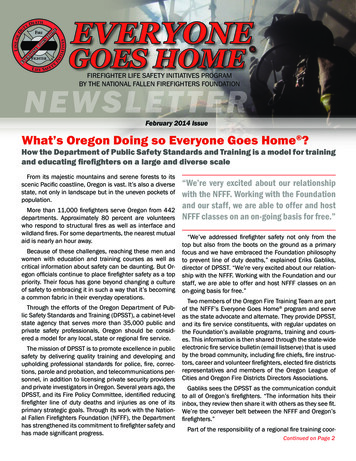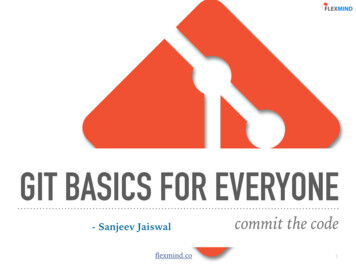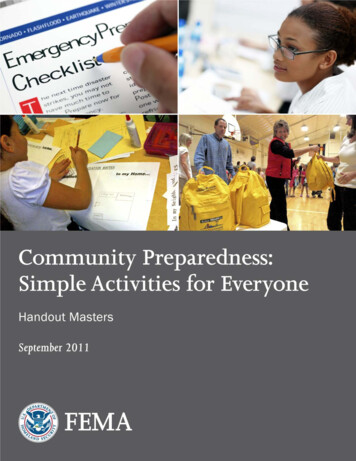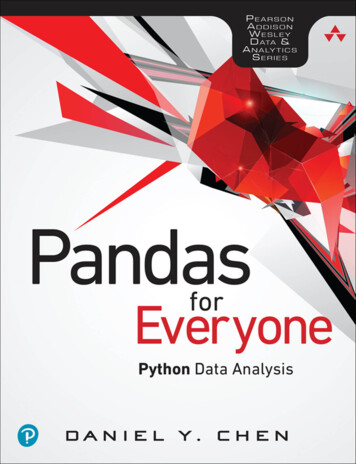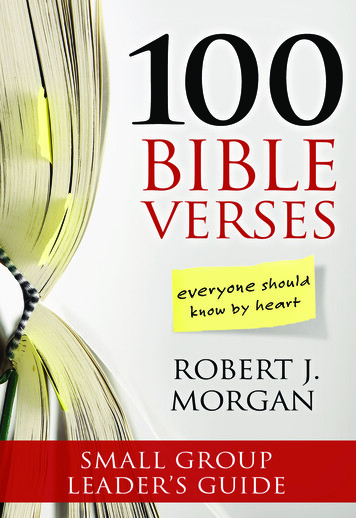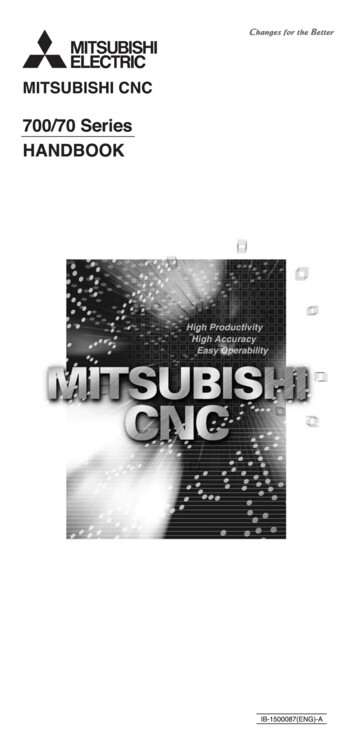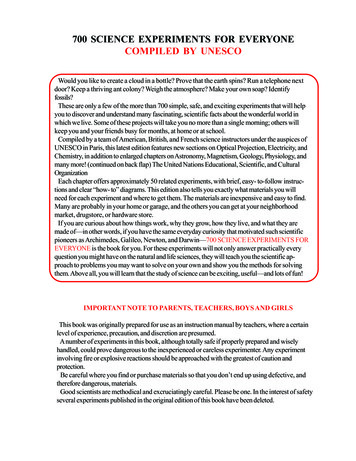
Transcription
700 SCIENCE EXPERIMENTS FOR EVERYONECOMPILED BY UNESCOWould you like to create a cloud in a bottle? Prove that the earth spins? Run a telephone nextdoor? Keep a thriving ant colony? Weigh the atmosphere? Make your own soap? Identifyfossils?These are only a few of the more than 700 simple, safe, and exciting experiments that will helpyou to discover and understand many fascinating, scientific facts about the wonderful world inwhich we live. Some of these projects will take you no more than a single morning; others willkeep you and your friends busy for months, at home or at school.Compiled by a team of American, British, and French science instructors under the auspices ofUNESCO in Paris, this latest edition features new sections on Optical Projection, Electricity, andChemistry, in addition to enlarged chapters on Astronomy, Magnetism, Geology, Physiology, andmany more! (continued on back flap) The United Nations Educational, Scientific, and CulturalOrganizationEach chapter offers approximately 50 related experiments, with brief, easy- to-follow instructions and clear “how- to” diagrams. This edition also tells you exactly what materials you willneed for each experiment and where to get them. The materials are inexpensive and easy to find.Many are probably in your home or garage, and the others you can get at your neighborhoodmarket, drugstore, or hardware store.If you are curious about how things work, why they grow, how they live, and what they aremade of—in other words, if you have the same everyday curiosity that motivated such scientificpioneers as Archimedes, Galileo, Newton, and Darwin—700 SCIENCE EXPERIMENTS FOREVERYONE is the book for you. For these experiments will not only answer practically everyquestion you might have on the natural and life sciences, they will teach you the scientific approach to problems you may want to solve on your own and show you the methods for solvingthem. Above all, you will learn that the study of science can be exciting, useful—and lots of fun!IMPORTANT NOTE TO PARENTS, TEACHERS, BOYS AND GIRLSThis book was originally prepared for use as an instruction manual by teachers, where a certainlevel of experience, precaution, and discretion are presumed.A number of experiments in this book, although totally safe if properly prepared and wiselyhandled, could prove dangerous to the inexperienced or careless experimenter. Any experimentinvolving fire or explosive reactions should be approached with the greatest of caution andprotection.Be careful where you find or purchase materials so that you don’t end up using defective, andtherefore dangerous, materials.Good scientists are methodical and excruciatingly careful. Please be one. In the interest of safetyseveral experiments published in the original edition of this book have been deleted.
IntroductionScience is perhaps unique as a subject in the curriculum of schools all over the world. This uniquenessresults from the variety of materials and experiments necessary for its effective teaching. Most other subjectscan be learned if ordinary tools are available, such as pencil, paper, blackboard, textbooks and a fewsupplementary aids. These are also essential for the teaching of science but, if they are the only tools,science becomes a dull and uninteresting subject.If it is to be learned effectively science must be experienced. It must be learned and not learned about.Science is so close to the life of every boy and girl that there is no need to confine its study to the reading oftextbooks or listening to lectures. Wherever you may go in the world, science is an intimate part of theenvironment—living things, the earth, the sky, air and water, heat and light and forces such as gravity. Noteacher need ever be without first-hand materials for the study of science.Good science teaching must be based on observation and experiment. There can be no substitute forthese. But performing experiments and learning to make close observations require special facilities, andthese are lacking in many parts of the world, especially at the elementary and early secondary levels. As aresult, science teaching suffers a severe handicap in these regions. It is often believed—thougherroneously—that to introduce laboratory teaching, even at the elementary level, requires elaborateequipment made by commercial manufacturers. Such materials are prohibitively expensive for mostelementary and early secondary teaching, and in many parts of the world are quite unobtainable becausethey are not manufactured locally and cannot be imported because of the cost.At the close of the second world war, many schools in many countries had been destroyed. As theseschools began to revive, there was a great need for science equipment; for these countries had a tradition ofbasing science teaching on observation and experiment. To meet this need, Unesco sponsored theproduction of a small volume entitled Suggestions for Science Teachers in Devastated Countries. This bookwas written by Mr. J. P. Stephenson (science master at the City of London School; member of the RoyalSociety Committee for Go-operation with Unesco, United Kingdom). While it proved very useful for thedevastated areas, it has had a phenomenal success in regions where previously there had been little or noequipment. Emphasizing the making and use of equipment from simple materials, the book has filled a greatneed in those countries where teachers are just becoming aware of the necessity for first-hand scienceexperiments even at the lowest levels of instruction. It has gone through several editions and has beentranslated into French, Spanish, Chinese, Thai and Arabic.Over the past few years, Unesco has sent many science teaching experts on field missions into areaswhere the need for the production and use of simple equipment is acute. These experts have hadopportunities to make and try out the materials and experiments suggested in the Stephenson book. Theyhave also had opportunities to go further in discovering other materials and devising new experiments, moresuitable for tropical regions for which the Stephenson book was not originally intended. The work of thesefield experts, together with the Stephenson book, has produced an array of simple equipment and scienceexperiments which needed to be assembled and described in one volume. This need has provided theimpetus for the production of the present 700 Science Experiments for Everyone.Believing that science and the scientific method of problem solving should play a significant role in anymodern educational scheme, Unesco offers this book in the hope that it will assist science teacherseverywhere in their important work. The point of view taken is that science is most effectively taught andlearned when both teacher and pupils practise the skills of problem-solving by engaging in group andindividual study. The devising of experiments and the improvising of simple equipment for carrying them outshould form no small part of such study. Thus, the present includes instructions for the making of manypieces of simple apparatus from materials usually found in almost any region. It also proposes a wide arrayof science experiments from which a teacher may select those most suitable for providing the observationsupon which effective learning may be based.These improvisations should not in any manner be regarded as makeshifts. The experiments and theexercise of constructing the apparatus are in the best traditions of science teaching. Many of the greatmasters of science have used such improvised apparatus and many of the great discoveries have been madewith improvised equipment.
No claim for completeness is made for this book. The array of available materials has made it difficult todecide exactly what should be included. But it is hoped that these pages will serve as a guide, and as astimulus to teachers and pupils to define their own science problems and then to improvise (from thingsthat may be locally available) the necessary equipment for experimenting. AcknowledgmentsScience is universal and knows no boundaries. This great store of human knowledge has been gleanedfrom a reluctant nature by workers of many lands. It is altogether fitting and proper that this 700 ScienceExperiments for Everyone should be a compilation of the work of experienced science teachers frommany countries. It is through the sharing of experience that science teaching can be improved and enabledto move forward.To give credit to all who have contributed to the making of this volume would be quite impossible. Muchof the material included has its origin buried deeply in the past and has come to be a part of a commonheritage of science teachers everywhere. Among those whose direct contributions have made this volumepossible mention should first be made of Mr. J. P. Stephenson of the City of London School. To him andhis collaborators we are indebted for the use of a large part of the material from the earlier Unescopublication Suggestions for Science Teachers in Devastated Countries. The impact of this little volume onscience teaching has been world-wide and it is already considered a classic in the literature of scienceeducation.Credit and appreciation are also due to: Dr. Glenn Plough of the University of Mary- land and Dr. PaulBlackwood of the United States Office of Education, Washington, D.C., for permission to use parts oftwo bulletins on teaching elementary science, of which they were co-authors; the National ScienceTeachers’Association of the United States, Mr. Robert Carleton, secretary, and through them, to Mr. GuyPruce of the Newark Teachers’ College, for generous permission to use material from the series entitledScience Teaching Today; and the New York State Department of Education which granted permission touse material from the two volumes of their publication, The General Science Handbook, Volumes I and II.Since the first appearance of the 700 Science Experiments for Everyone in December 1956, manyvaluable comments and suggestions have been received, and reviews have appeared in journals in all partsof the world. This has led to minor revisions being made in each of the reprints. The first edition in Englishwas reprinted eleven times, and the French edition is in its fourth impression. Translations have beenpublished in seven other languages, while fourteen additional translations are in preparation.The following were among the contributors of useful suggestions: Dr. F. J. Olsen of the Department ofEducation, University of Queensland, Australia, and a former President of the Australian ScienceTeachers’Association; Dr. W. Llowarch of the University of London Institute of Education and Dr. VidaRisberg, a former Unesco specialist in science teaching to the Philippines.To begin withA Few Words to Boys and Girls about This BookIt is probably only a legend that the idea of gravitation hit Sir Isaac Newton’s mind when a falling apple hithis head. But the truth is that the simplest experiment, or even such an accident, can be an eye-opener whenyou are interested in the world around you. When the great Creek scientist, Archimedes, was puzzling aboutwhy some objects float on water and others sink, it is quite possible that the underwater lightness of his ownbody in the bathtub gave him the first hint of the answer. Certainly Charles Darwin’s thinking out of thetheory of evolution was the result of very careful observation of the plants and animals that he collected,including shells and fossils. These pioneers were all amateurs who had no elaborate apparatus to work with,and no textbooks either. That is the way science began.You can begin your understanding of science that way too, and have a wonderful time exploring. Theworld we live in is as interesting as ever. In fact, with modern inventions now added, it is much more so. Youdo not need to wait for someone to explain the science behind the automobile engine, television, rocketflights in space, the development of new fruits and vegetables, or the causes of disease. You can investigatethese ideas yourself.
Of course, you must begin at the beginning if you want to understand. But all the complex products ofmodern science are only combinations and developments of a few basic principles that govern the world.You can convince yourself and your family and friends that they are true by many easy experiments that youcan do at home with common materials from the kitchen, the garage, or a nearby store. This book isintended to help you to do it.You will be teaching yourself science, getting ready to join a science club or to take part in a school orcounty science fair. Then you will find the science textbooks easy to understand when you get to them. Bestof all, you will be in the habit of having ideas and of trying them out, which is the common trait of allinventors and research men from Edison to Einstein. That trait is the source of almost all human progress,from the invention of the wheel and the sailboat to placing a man-made moon in an orbit around the earth.This book is not a chemistry kit or a physics kit and does not need one. It is an idea kit. It describeshundreds of experiments that you can do for yourself, lists the simple things and materials that you need forthem, and suggests what to do. The directions are brief and simple.During each experiment you will draw your own conclusions about what it means or proves—and it’s agood idea to write down your measurements and your conclusions in a special notebook. If your mind is ashealthy and active as your muscles are, you will probably have many questions after each experiment—andyou should write them down too. Some of them will be answered by the experiments that follow. For othersyou will want to look up the answers in an elementary science textbook in your school or library.Often when you think about an experiment you may discover that you have different things around thehouse that will serve the same purpose.Or you may think of other ways to prove the same thing. All the better. Certainly you will think of otherexperiments to do that are not in the book. Very good, because the experiments in this book are designed tostart you thinking. One thing they will do: they will convince you that experimenting in science is fun and thatthinking about science is exciting.In the front pages of the book you will find a few suggestions for teachers, because this book wasoriginally written for teachers in some countries where the schools do not have modern laboratories orperhaps have no laboratory at all. But these sections are not for you—not at the start at least; you can comeback to them later. You will also find a list of tools, materials, and supplies that will be needed if you do allthe experiments. But neither is this the place to start; you can find or get the materials as you need them.The experiments begin with Chapter III, and the first chapters deal with botany, zoology, mineralogy, andastronomy. Start with them, if you like, or start with the experiments on air in Chapter VII. This is the first often chapters on common materials—like air, water, and solids—and on energy—including heat, light, andelectricity—which introduce the science of physics. When you have done these experiments you willunderstand many things in nature and about modern machines that have seemed mysterious and you will beable to explain them to your friends.One more thing about this book: Science is international, the same all over the world. It is studied in everycountry and in every language. This book was prepared by an agency of the United Nations (the UnitedNations Educational, Scientific, and Cultural Organization, usually called UNESCO from its initials) for usein all of them. As the UNESCO Source Book for Science Teaching it has been translated not only into thelanguages of Europe, such as French and Spanish, but also into many Asian languages, such as Arabic,Tamil, Hebrew, and even Chinese. So the experiments you do are being done at the same time by thestudents in South America, Europe, Asia, and Africa. Their languages and customs are different, but theirexperiments and their science are the very same as yours.This English-language edition was prepared not only for the United States, but for all the countries thatspeak English, including England and Canada as well as Australia, New Zealand, India, South Africa, andmany smaller ones. So it must be mentioned here that there are a few slight differences in spelling and in theuse of some words between the United States and the other English-speaking countries. The United Nations
have formally adopted the British, rather than the American forms. So you will find, for instance, that “color”is spelled “colour” in this book, and “aluminum” is “aluminium.” These are not errors; they are just BritishEnglish. What we call a “can” is called a “tin” in England, and a “flashlight” is a “torch.” But these differencesare very rare and they will not confuse you.Now the book is yours, get going and have fun learning science.GERALD WENDTFormer Head, Division of Science Education, UNESCOThe purposes of this bookThere are many places in the world where both facilities and equipment for science teaching are at presentinadequate. Such places are to be found in areas that are more advanced in the applications of science, aswell as in other regions. This volume has been produced to help the trend of upgrading science instruction inschools and training colleges everywhere by basing it more and more on observation and experiment. Thebasic purposes may be summarized as follows:1 To provide a basis for better instruction in methods of teaching science in teacher-training institutions.2 To provide a useful source of learning experiences and materials for science teachers in the elementaryand secondary schools.3 To provide a manual which may be used as a partial basis of instruction in science teaching methods forworkshops and courses for the in-service training of teachers.4 To provide a basis for the assembling of a loan collection of teaching kits containing simple equipmentfor science.To provide some suggestive materials for science clubs and for other amateur science activities.To provide a model or pattern so planned and developed that it can easily be adapted to science teachingconditions in many countries and translated into the national language.SUGGESTED USES FOR THIS BOOKIn teacher-training institutionsYoung teachers in training do not learn the methods of effective science teaching merely by listening tolecturers in colleges; they must have some contact in their training period with the many problems to be metlater in the classroom. The teaching of science must have special consideration above and beyond what isusually given in a general methods course—this because science is unique as a subject in the schoolcurriculum as using specialized materials, equipment and methods of approach. If the standards of scienceinstruction are to be raised, such a special course in the techniques of teaching it must be in the curriculum ofevery teacher- training college.A large part of a course in the methods of teaching science should be devoted to the practical orlaboratory phase in which young teachers are given instruction in the devising, designing and construction ofsimple laboratory equipment from materials available in the community where they will teach. Only throughsuch training will they be stimulated to base their teaching on observation and experiment.In this practical course, the young teacher should find the opportunity to construct many pieces ofequipment to carry out to his first teaching assignment. He might even be encouraged to begin the assemblyof a nucleus of teaching kits.
A source book for science teachersMany teachers who have not had an opportunity to study science appear to be afraid to teach it. In manycases this fear of the subject arises because they do not know how to assemble apparatus or to marshal thespecialized learning experiences required. This book can be used by such teachers as a source of instructionfor making the simple equipment needed and as a source of a variety of learning experiences for teachingalmost any topic in the curriculum. In this way the teaching can be improved and enriched.This book should also help to create and maintain a higher level of interest in science on the part of thepupil. Every child is by nature an experimenter. He is curious about why things happen and likes to try outhis ideas. Even outside the school, children are constantly experimenting. Many young people will likehelping to construct apparatus and to test the ideas proposed in their classroom experiences.Pupil committees may be used in the building of many of the pieces of apparatus suggested as well as inassembling them into useful kits to be used in later experiments. If there is a work- shop in the school, theteacher may co-operate by letting pupils make science equipment as special projects.As a basis for workshop study conferences in science teachingThe workshop study conference is now a well-established and widely used device for the training ofteachers in service. Such conferences have been held for science teachers in many parts of the world. It isonly through them that teachers now teaching can be influenced to improve their practices and change theirpresent conditions.This book can serve as a useful basis both for instruction in methods of teaching science and for alaboratory practice where teachers are given instruction in the simple techniques of making improvisedapparatus. They might then be encouraged to begin the training of other teachers in the area.To provide the basis for assembling a loan library of simple science teaching kitsWhile the ideal situation would be for every school to assemble the simple equipment needed for teachingthe various science units, this may not always be feasible because of lack of funds or time. Another schemeis to assemble kits of simple equipment for doing experiments. Each kit is assembled in a durable box with ahinged cover that latches securely. The kits are then stored in a central school and loaned out to teachers inthe schools of the neighbourhood in much the same way as library books are loaned. Each kit also containsa list of the materials in the box as well as directions for doing the experiments.The plan operates in this way. Assume that kits have been assembled and stored in a centrally locatedschool. Perhaps the teachers in that school would take responsibility for keeping the kits in good order andmaking the necessary records. A card should be made out for each kit. Now let us suppose that a teacher inschool X is planning to teach a unit on magnetism during the next week. She goes to the school where thekits are kept and fills out a card stating when she will need the kit on magnetism and when she will return it.The teacher in charge takes her card and then notes on the kit card, her name, the school and the dates. Thekit is then issued to the teacher, and she takes it to her classroom for use. At the end of the unit the materialsare carefully checked against the list and any breakage noted. The kit is then returned to the depository.A project for assembling a library of simple equipment kits might be undertaken in several ways. One waywould be to have the boxes made according to the pattern suggested above, by boys in a vocational school.The kits might be assembled at a central place or the project could be made co-operative by having eachteacher, with her class, assume responsibility for assembling and making the necessary materials for oneteaching kit. Another plan might be worked out in which students in training at a teacher-training collegecould be assigned projects of assembling the kits for schools in a given locality.
As a source book for science club activitiesScience club sponsors often find it a problem to provide worth-while projects and activities for clubmembers. The many projects and experiments suggested in this book are appropriate for use by youngpeople of all ages as science club projects.To provide a model pattern of science materials and activities for many countriesThe format of this book has been so planned, and the materials so selected as to make it adaptable toalmost any local situation. The text materials and the simple line drawings can easily be reproduced.TOOLS NEEDED FOR MAKING SIMPLE EQUIPMENTEvery school where elementary or general science is taught should be provided with some sort of workbench where simple equipment can be made. An old table can be used for this purpose. If no space isavailable for a work bench, a few rough boards cut to the right length may be placed on a school desk toprevent injury to the desk top. Such boards may be padded on the under side with cloth. A work bench willprovide a place to hammer and saw. A good supply of old newspapers is always useful to put on the floor,especially if any painting is to be done.MATERIALS AND SUPPLIESThe materials needed for making simple equipment will vary from place to place and class to class. It ispossible however to suggest a few basic materials and where they can be obtained.Hammers Screwdrivers Pliers Small wood saw Hack or metal saw Small block plane Wood chisel Braceand bits Gimlet Old pans of various sizes Tablespoons and teaspoons Cups and saucersFrom the homeDinner plates Soup plates Bottles, various shapes and sizes Tin cans, various sizes with and without coversGlass jars, various shapes and sizes
CHAPTER ISOME SUGGESTIONS ABOUT THE TEACHING OF GENERAL SCIENCEA. GENERAL SCIENCEWhat is it?Where is it? In the primary school, children are seeking simple answers to their questions, which usuallybegin with: ‘What is it?’ First of all, science is not a lot of things it was once thought to be; not a series ofobject lessons about a piece of granite, an old wasp’s nest, an acorn, or a tulip. It is not hit and miss likethat, not learning the names of the parts of a grass- hopper or a flower; not learning to identify 20 trees, 20insects, 20 flowers or 20 anything else.What is science, then? It is a study of the problems that are found wherever children live. More formallystated, it is a study of the natural environment—not merely pieces of chemistry and physics and biologyand astronomy and geology. Its content is connected with those subjects but it is a study of problems thatpop into curious children’s minds as they live and grow from one day to the next, such as: What makes thewind blow? What’s in a cloud? What’s a stone made of? What does a bell do when it rings? How can aseed grow into a tree ? What makes a rainbow? Anyone who has ever worked with primary school girlsand boys knows that most of them are full of questions like this and like to know the answers to them. Well,finding the answers to such questions— that is science.And it need not be too technical. The full explanation is not what the l0-year-old needs. He could notunderstand that. It is a foundation in simple terms of the how, the when, the where, and the what of thethings that happen around him every day. That is his science. He doesn’t need the technical terms, theformulas and the detailed explanations. Those will come later, but when he is 10 he chiefly needs to getsatisfaction out of his tendency to be curious. He needs to have his curiosity broadened, his interestsnurtured and his enthusiasms encouraged. That is the kind of science which fits him and with which he is ableto deal.Where is it?Science in the primary school—where is it? It is everywhere that schoolchildren are: in the air theybreathe, in the water they drink, in the food they eat. ‘What’s oxygen?’, ‘How do minerals get into water?’,‘What’s a vitamin ?’Science is in the things they see on their way to school: ‘How does electricity make a street car move?’,‘Why does my dog stick out his tongue when he pants in hot weather?’, ‘What makes the sky blue?’Science is in their homes: ‘What makes our doorbell work?’, ‘What makes lemons taste sour?’ ‘Howdoes our furnace heat our house ;’Science is in the schoolhouse: ‘How can the fire extinguisher put out a fire?’, ‘What made the rust in thedrinking fountain?’, ‘Why did we all have to be vaccinated?’Science, then, is all around the girls and boys we teach. They cannot help but see it. They will see more ofit with a little help. They will get more interested in it with a little encouragement. They’ll learn more about itwith a teacher who sees the possibility of its use, and uses his teaching skill to help children learn about theirenvironment.What can it do?It is generally true that a well-informed person is an interesting one, and some information regarding theenvironment is one of the pieces of equipment that go to make up an informed individual. That does notmean that you expect to pump your pupils full of facts that they can merely use to fill up blank spaces inconversation. It means that you want to help them to come to learn generalizations or meanings which theycan use in interpreting problems in their environment.
To illustrate: The members of the lily family have three sepals, three petals usually coloured alike, sixstamens, one pistil, etc. A boy aged 10 can certainly live a full and well-rounded life without committing thisto memory. But suppose he learns through an examination of many plants and many animals that ‘Plantsand animals are put into groups according to certain characteristics, and that knowing these characteristicshelps you know the large group to which the living thing belongs’. This generalization can then be helpful inidentifying animals and plants he sees, and make it possible for him to study their habits, to determine theirhelpfulness or harmfulness, and so on. He has become aware of this generalization through careful study andthrough observation, and by pressing together many small ideas into o
Introduction Science is perhaps unique as a subject in the curriculum of schools all over the world. This uniqueness results from the variety of materials and e






